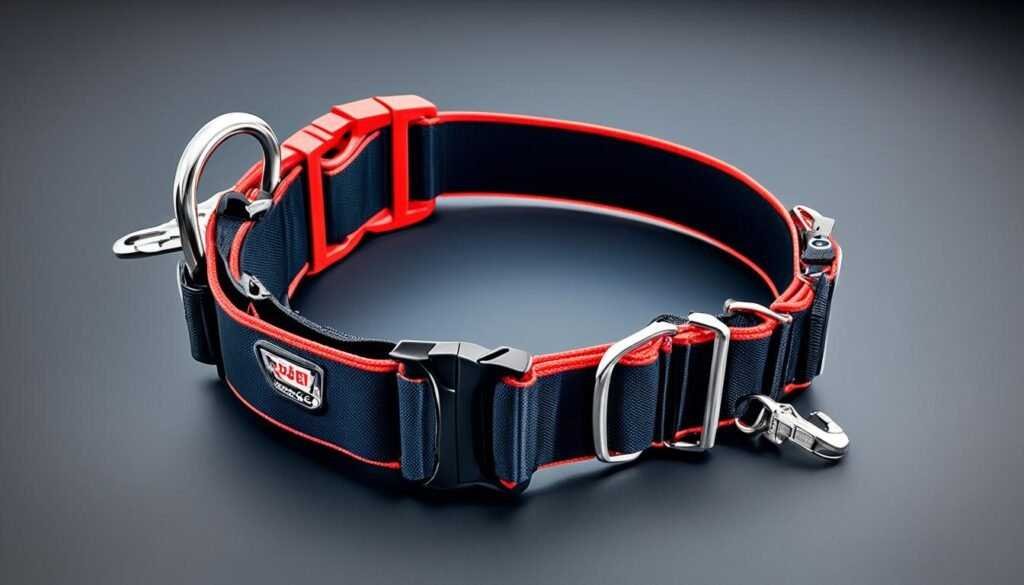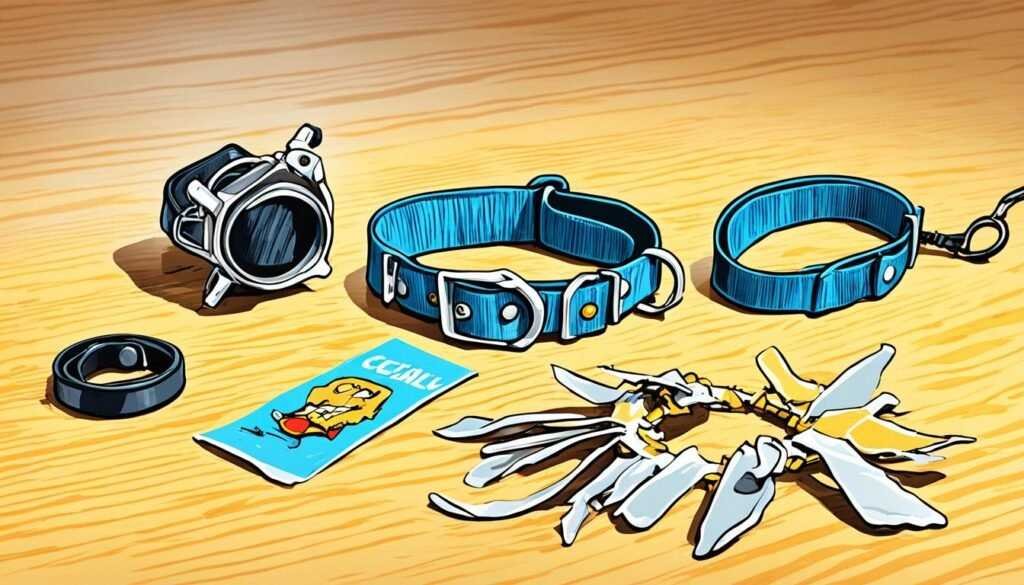- Understanding the Shock Collar Mechanism
- When to Consider Using a Shock Collar
- How to Use a Shock Collar to Stop Bad Behavior
- How To Use A Shock Collar To Stop Bad Behavior
- Conclusion
- FAQ
- When should I consider using a shock collar for my dog's training?
- How do I properly use a shock collar to address my dog's behavioral issues?
- Can a shock collar be effective in addressing aggressive behavior in dogs?
- How can I use a shock collar to stop my dog's excessive barking?
- Can a shock collar be used to address my dog's reactivity to other dogs during hikes?
As a devoted pet parent, you might face challenges with your furry friend’s behavior. The shock collar has sparked debate in dog training. It can be a useful tool if used right and with professional advice.
Experts say to use shock collars only after trying positive methods. The author of this piece adopted an Anatolian shepherd named Teddy who barked too much. They tried the Garmin Sport Pro training system, which has a collar and a handheld controller for automatic bark correction.

At first, the idea of shock collars worried the author. But a friend convinced them to try it. They found the shock wasn’t too harsh and helped stop Teddy’s barking. It didn’t change his personality or mood.
Understanding the Shock Collar Mechanism
Using dog training collars means knowing how shock collars work. These devices send a small electrical shock to a dog’s neck for certain behaviors. They are also called remote training devices.
The Best Dog Training Collar and System
Choosing the right shock collar is key to its success. Make sure it fits your dog well, with the electrodes touching the skin. Nylon or cotton collars are good because they’re breathable and soft. Dogs with sensitive skin might do better with collars covered in soft fleece or satin.
Introduce the shock collar slowly, making sure your dog sees it as positive. Use treats and fun times to help them get used to it. This way, they won’t think the collar is a punishment. Teach them that their actions cause the shock, using verbal commands to help them learn.
Using shock collars right takes knowledge, patience, and a focus on positive reinforcement. It’s smart to get advice from trusted sources that support scientific and behavior-based training. This ensures you’re using these obedience training tools responsibly and effectively.
“To ensure proper and responsible use of shock collars, seeking guidance from reliable and verified sources that emphasize scientific and behavioral-based methods is recommended.”
When to Consider Using a Shock Collar
Shock collars, also known as dog training collars, e-collars, or electronic collars, can be useful for behavior modification. They should be used responsibly and with positive reinforcement. It’s key to use them only after trying positive methods and with a pro’s advice.
These collars can help with behaviors that make a dog unhappy or hard to live with. For example, if a dog barks too much and it’s a problem, a shock collar might be considered.
But, shock collars can cause pain, fear, or anxiety in dogs. Studies show that using them wrong can make bad behaviors worse and upset dogs.
If you’re thinking about a shock collar, work with a certified pro. They can help use it right and with positive training. This way, you tackle the real issues, not just the symptoms.
| Benefit of Shock Collars | Potential Drawbacks of Shock Collars |
|---|---|
| Can be effective in modifying persistent behaviors that significantly impact a dog’s quality of life | Potential to cause pain, fear, or anxiety in dogs if misused or used inappropriately |
| Provide instant feedback and remote control for the owner | Can reinforce undesirable behaviors and create confusion or anxiety in dogs |
| Can be used with electronic fencing to deter dogs from crossing boundaries | Aversive training methods do not address the underlying problem causing the undesirable behavior |
Remember, positive reinforcement training is the best and kindest way to train dogs. Shock collars might be used in some cases, but always choose positive reinforcement and get a pro’s advice for ethical use.

“The use of electric shock collars is not consistent with animal welfare principles and should not be used as a training method for dogs.”
How to Use a Shock Collar to Stop Bad Behavior
Training and Barking
Many pet owners deal with dogs that bark too much. This can be a big problem at home. A shock collar can help stop this. Look for one with an automatic feature, like the Garmin Sport Pro, to stop your dog’s barking without hurting them.
To use a shock collar for barking, start with the lowest setting. Increase it until it works but doesn’t hurt your dog. Always use it with positive training to teach good behavior.
Hiking and Other Dogs
For those who like hiking with their dogs, dealing with other dogs on the trail can be tough. A shock collar with a manual feature can help. It can help your dog focus on you instead of other dogs.
Start with a low setting and increase it as needed. Always use it with positive training to fix the root of the problem.

Using a shock collar with positive training can help with many issues, like too much barking or reacting to other dogs. Always watch how your dog reacts and adjust the collar to keep them safe and happy.
How To Use A Shock Collar To Stop Bad Behavior
Using shock collars to fix behavioral problems in dogs is a debated topic. When done right and with positive reinforcement, they can help stop bad behaviors like too much barking or reacting to other dogs. This is true when used with care and under expert advice.
Many countries are thinking about limiting or banning shock and prong collars. This is because some dogs get hurt or die from these devices every year. Yet, millions of dogs are still using these collars, and many end up in shelters because they can’t handle their behavior.
It’s key to work with a pro dog trainer or vet to use shock collars right. They can teach you how to use it to change behavior for the better. They also stress the need for positive reinforcement for lasting changes in your dog.
“The past 15-20 years have seen advancements in dog training techniques, moving towards more modern, science-based approaches that do not rely on causing discomfort or pain to dogs through tools like shock collars.”
Remember, shock collars should be a last choice after trying positive methods first. The aim is to fix the behavior’s root, not just hide it. With the right help and a balanced method, shock collars can be a useful tool in training your dog. They ensure your dog is treated kindly and responsibly.
| Key Statistic | Detailed Information |
|---|---|
| Decline in E-collar Use | The use of E-collars in dog training has declined in the UK from an estimated 6% of all pet dogs in 2012 to around 1% in 2019. However, it’s estimated that around 100,000 dogs in the UK are still subjected to E-collar use despite the decrease in popularity. |
| Study on Shock Collars | A study examining the efficacy of electronic collars to improve recall and general obedience involved 63 dogs, with 21 dogs in each of the three training groups. Gundogs and cross-breeds were the most commonly represented breed types, each making up 25% of the study population. 54% of the dogs in the study were female, with 33% of these being neutered females. The study focused on dogs older than 9 months with no prior experience with electronic collars. |

Conclusion
This article has shown how to use a shock collar to stop bad behavior in dogs. It stressed the need for responsible use and professional guidance. Shock collars can help with behavioral issues, but only after trying positive reinforcement techniques.
They should be part of a complete training program that boosts the dog’s confidence and uses obedience commands.
It’s important to make sure the collar fits well and start with low settings. Increase levels as needed for humane and effective use. The aim is to make dogs happier by solving problem behaviors in a way that respects their nature.
Choosing between electronic collars and reward-based training is up to you. The main thing is to focus on responsible pet ownership and behavior modification that cares for the dog’s well-being.
By understanding aversive training methods and other obedience training tools, you can make a choice that fits your dog and your training style.
FAQ
When should I consider using a shock collar for my dog’s training?
Experts say use shock collars only when positive methods don’t work. Always get a pro or vet to help. They should be a last choice, part of a bigger training plan that uses positive rewards.
How do I properly use a shock collar to address my dog’s behavioral issues?
Let your dog get used to the collar first. Start with the lowest setting and increase as needed. Don’t let your dog see you using it to avoid linking the shock to you, not the behavior. Use it with positive rewards too.
Can a shock collar be effective in addressing aggressive behavior in dogs?
Yes, shock collars can help in a full training plan that uses positive reinforcement. But, make sure to work with a pro or vet to use it right and humanely.
How can I use a shock collar to stop my dog’s excessive barking?
Shock collars can help with too much barking, especially with an automatic feature. Begin with the lowest setting and adjust as needed. Make sure the collar doesn’t upset your dog too much or change their mood.
Can a shock collar be used to address my dog’s reactivity to other dogs during hikes?
Yes, the manual feature of a shock collar can help focus your dog away from other dogs on hikes. This can help you earn off-leash freedom while keeping control. But, always work with a pro to use it right and humanely.






